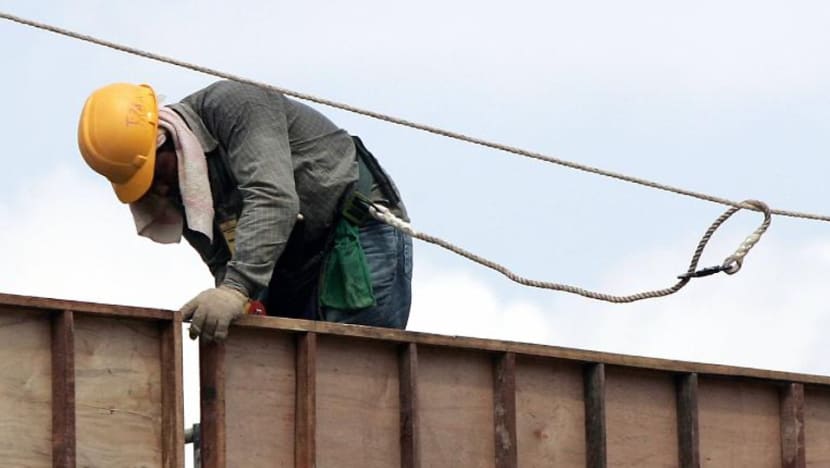Construction worker who fell to his death in Tampines did not secure harness to life line: Coroner

A construction worker secured on a harness. (File photo: AFP/Roslan Rahman)
SINGAPORE: A construction worker who fell down a shaft at a site in Tampines in 2017 and died did not secure his harness to any anchorage point, a coroner's inquiry found on Tuesday (Jan 29).
Mr Wu Sanyuan, 51, had been working for China Jingye Engineering Corporation at the construction site of a condominium in Tampines Avenue 10 on Dec 18, 2017 when the accident occurred.
The Chinese national was instructed by the work site supervisor to dismantle the aluminium casings at a mechanical ventilation shaft - a vertical passage meant for better air circulation - between levels 10 and 11.
He was meant to work on the casings with another colleague, Mr Liao Jigang, but Mr Liao left his partner to help another colleague at around 9.30am.
Nobody saw Mr Wu's fall, and he was discovered on a wooden plank at level four of the shaft only after Mr Liao realised he was missing at around 10.30am, which then sparked a search for him.
Paramedics pronounced him dead at around 11.30am, and forensic findings certified that he had died from multiple injuries consistent with a fall from height.
DECEASED DID NOT HAVE HABIT OF USING LIFE LINES: COLLEAGUE
According to Mr Liao's testimony, both Mr Wu and himself were wearing safety harnesses while dismantling the casing.
They were supposed to set up a "life line", or an anchorage point which they would secure the harnesses to, but they did not as the shaft was small, and the life line "would have hindered their movements while working".
Mr Liao also said that neither of them placed a wooden plank at each level of the shaft as part of the company's safety procedures, admitting that this was an oversight.
The planks should have been placed at each level to break a fall.
Mr Liao believed that the plank on the fourth floor that Mr Wu had fallen on had been left there by other colleagues.
He also believed that Mr Wu did not not have the habit of using life lines and wooden planks while working.
The colleague that Mr Liao had gone to help also testified that he believed other colleagues would not deploy life lines as it might be troublesome.
HE COULD HAVE FALLEN BY LOSING HIS FOOTING: MOM
An investigation report by the Ministry of Manpower, which issued a full stop-work order at the time, suggested several possible scenarios for how Mr Wu could have fallen.
He could have lost his footing while standing on slabs protruding over the shaft, or while attempting to climb up rungs to exit the shaft.
After the incident, a notification was sent to industry insiders to create awareness of what went wrong, in order to prevent a recurrence.
The suggested measures that should have been in place included a thorough risk assessment, an effective fall arrest system, and sufficient lighting.
MOM lifted the stop-work order on Jan 29, 2018 only after adequate measures had been set up.
State Coroner Kamala Ponnampalam called Mr Wu's death "a tragic industrial misadventure" and extended her condolences to Mr Wu's wife and family.














